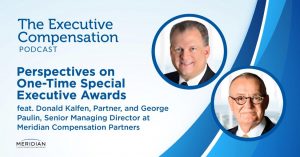 Donald Kalfen
Donald Kalfen
 George Paulin
George Paulin

When Competitive Regular Pay Is Not Enough
It is common practice for public companies to make regular long-term incentive awards to executives as part of their annual total compensation. In addition, one-time special awards are sometimes made for various reasons including support for critical strategic initiatives, recognition and retention of high performers, promotions, and new-hire inducements.
Special awards generally are criticized by the large investment funds and proxy advisors, and often lead to say-on-pay opposition when made to CEOs and other senior officers named in company proxy statements. If total annual compensation is already competitive and has significant performance-related upside in the regular long-term awards, then why are special awards on-top of the regular awards necessary?
To help inform decisions at companies considering such awards, we researched the structure, rationale, and say-on-pay voting experience related to recent special awards to CEOs at major public companies. Our findings and conclusions were the subject of an episode of Meridian’s Executive Compensation Podcast Series (see MeridianCP.com) and are summarized in this article.
Examples of Recent CEO Special Awards
The following criteria were used to identify 35 recent CEO special awards included in our analysis:
- Special awards of at least $10 million in addition to regular annual long-term incentive awards.
- Fortune 500 companies without ownership-controlled voting.
- Say-on-pay voting results available, which essentially limited award timing from proxies for 2012 to 2020.
- No “buy-outs” in recruiting packages that were not new money or “front-loads” to be later offset from future regular grants.
Key Takeaways
There were five notable findings from the data, as described below:
- Say-on-pay results were not all bad. Over half of the special awards (54%) resulted in say-on-pay approval above the 70% “bright-line” commonly regarded as acceptable, where no major response to shareholder feedback is expected in the following year. Only six (17%) failed.
- Institutional Shareholder Services’ (ISS) voting recommendations were evenly split. There were “for” recommendations on 51% of the awards and “against” recommendations on 49%. Support was more likely when the amounts were relatively lower, there was a performance-based structure, and voting was before 2019.
- Representative large investment funds were more-supportive than ISS. For example, Vanguard supported 78% of the awards, BlackRock supported 89%, and State Street supported 70%. Here, the strength of company performance at the time of the award seemed to be another important factor.
- The environment changed starting with voting in 2019. Two-thirds of ISS’ against recommendations were for awards reported in 2019 proxies or after, compared to only one-third before. In the meantime, Vanguard amended its voting policy with a negative provision on special awards in 2019. BlackRock took similar action in 2021, warning of increased scrutiny going forward. ISS, on the other hand, has no specific policy prohibiting special awards, but structures its quantitative “CEO Pay-for-Performance Test” so that a special award counts in two of the related analyses (Relative Degree of Alignment and Multiple of Median) with an adverse impact.
- A majority of the six special awards that resulted in say-on-pay failure shared commonalities. All six of these awards were reported in proxies filed in 2019 or after, while none reported in earlier proxies resulted in say-on-pay failure. Five of the six awards (83%) were for $25 million or more, and four of the six (67%) were all or partly time-based.
- Eight other special awards reported in proxies filed in 2019 or after did not result in say-on-pay failure. Three of these were for $25 million, and all eight were entirely time-based. Three had greater than 70% approval. Consequently, factors other than quantum, structure, and less-conducive more-recent environment also had an impact—likely including business rationale, shareholder composition, and company performance in year of grant.
Voting Policy Detail
While ISS has no specific prohibition regarding special awards, they apply close scrutiny in evaluating the magnitude of pay in their quantitative CEO Pay-for- Performance Test. Further, award structure and rationale are evaluated in the qualitative review of pay practices that is more rigorous when a company has elevated concern on the qualitative test, which would be more likely with a special award of any substantive size.
Glass Lewis similarly has no outright prohibition. They evaluate the magnitude of pay in their overall assessment of compensation. Structure, rationale, and disclosure are evaluated in their one-time award policy, where they warn that such awards could “…adversely impact the pay-for-performance evaluation, causing issuance of a negative say-on-pay vote recommendation.”
As previously discussed, policies are in place at Vanguard and BlackRock among the large investment funds that have sophisticated internal governance staffs. Vanguard’s policy states that “one-time (e.g., retention) awards are a ‘yellow flag’ that may trigger a negative say-on-pay vote.” BlackRock’s policy states that they are “generally not supportive of special bonuses unrelated to company and individual performance.”
Award Amounts, Structure, and Rationale Detail
In our sample, special award amounts ranged from $10 million to $100 million with 54% less than or equal to $15 million, 29% greater than $15 million but less than $25 million, and 17% greater than $25 million.
Structure was a mix of performance- and time-based with 40% all performance-based; 29% part performance- and part time-based; and 31% all time-based, roughly evenly split between restricted stock and stock options.
Most of the special awards were attributed to retention concerns, eliciting an often skeptical external reaction as buy-outs of forfeited value have become the prevailing market-practice in recruiting. New-hire inducements, not buy outs, and promotions were the next most-often reasons cited for making the special awards. Disclosure of rationale often was not robust.
In Conclusion
Faced with high attrition and costly ongoing pay packages for new hires, companies battling in the war for talent that is particularly intense in financial services, drug- development, and technology are increasingly considering special awards. Below the proxy-officer level, considerations are primarily cost, precedent, and internal equitability.
Say-on-pay governance becomes an additional consideration at the proxy-officer level that requires disclosure to an audience that has become increasingly skeptical of special awards and needs to be convinced otherwise. This takes scrupulous alignment to justify on-top pay for on-top performance. It also takes a credible disclosed rationale beyond just simple retention because high-performing special-award recipients are likely to realize the award value one way or another, by staying to vest or leaving with buy out that makes them whole for the forfeited value.
